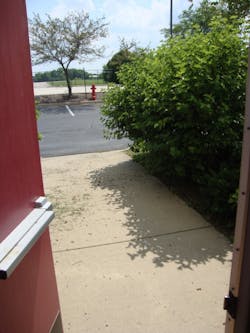Mitigating Mistakes: Vegetation vulnerabilities
Editor’s note: “Mitigating Mistakes” is a monthly SecurityInfoWatch.com column series from security consultant and author Paul Timm featuring photos of security vulnerabilities discovered in the field followed by a discussion on the problems they present to a facility’s security posture and how they can be addressed.
Finding: While conducting security assessments, I often encounter vegetation at entrances, walkways and parking lots that obscures clear lines of sight. Spring rains, warming temperatures and increasing daylight combine to maximize growth at this time of year.
Problem: Vegetation that is not properly trimmed affords areas of concealment to those with malevolent intent. As a result, criminal activities and associated behaviors cannot easily be seen. The perception of limited visibility may even embolden potential offenders.
Lesson: In Crime Prevention Through Environmental Design (CPTED), the principle of “natural surveillance” speaks to the need for maximizing visibility and increasing the perception that people and activities can be seen. Improved natural surveillance makes potential offenders feel an increased risk of being detected.
Remedy: Address the vegetation on your property. Especially at entrances, walkways and parking lots, remove tree limbs to a minimum height of eight (8) feet. In the same areas, trim shrubbery to a maximum height of 36 inches or replace it with miniature shrubs. Be proactive. Now is the time to reduce risk by improving natural surveillance.
About the Author:
Paul Timm, Vice President of Facility Engineering Associates, is a board-certified Physical Security Professional (PSP), the author of School Security: How to Build and Strengthen a School Safety Program, and a nationally acclaimed expert in physical security. In addition to conducting numerous vulnerability assessments and his frequent keynote addresses, Paul is an experienced Crisis Assistance Team volunteer through the National Organization for Victims Assistance (NOVA). He is certified in Vulnerability Assessment Methodology (VAM) through Sandia National Laboratories and the ALPHA vulnerability assessment methodology. He is also a member of ASIS International’s School Safety & Security Council and the Illinois Association of School Business Officials’ Risk Management Committee. Paul recently earned his Master’s degree from Moody Theological Seminary.
About the Author

Paul Timm, PSP
President, RETA Security, Inc.
Paul Timm, Vice President of Facility Engineering Associates, is a board-certified Physical Security Professional (PSP), the author of School Security: How to Build and Strengthen a School Safety Program, and a nationally acclaimed expert in physical security. In addition to conducting numerous vulnerability assessments and his frequent keynote addresses, Paul is an experienced Crisis Assistance Team volunteer through the National Organization for Victims Assistance (NOVA). He is certified in Vulnerability Assessment Methodology (VAM) through Sandia National Laboratories and the ALPHA vulnerability assessment methodology. He is also a member of ASIS International’s School Safety & Security Council and the Illinois Association of School Business Officials’ Risk Management Committee. Paul recently earned his Master’s degree from Moody Theological Seminary.
